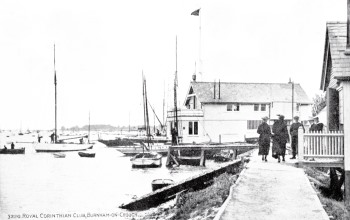Coastguard Watch Vesels on the Rivers Crouch and Roach
Coastguard Watch Boats - Darwin's
connection to Burnham-on-Crouch
HMS Beagle, HMS Chanticleer,
HMS Kangaroo, HMS Frolic and HMS Lucifer
The Beagle

HMS Beagle was a Cherokee
Class 10 gun brig built at Woolwich Dockyard in 1820 for the
Royal Navy.
Beagle was 90 feet in length
and weighed 235 tons with an 11 foot draught.
Sadly for the Beagle the Navy
she was built 5 years after the defeat of the French at Waterloo and
at a time of peace and a shrinking Navy she was mothballed for 5
years
In 1826 The Navy fitted out
the Beagle as a survey
ship by adding another mast and fitting 6 extra guns which changed
her class from brig to barque rigged sloop. Under the commander
Robert Fitzroy she then voyaged to the pacific napping the Coast of
Southern America returning in 1830.
The survey was regarded as a
success and a further survey was agreed this time by
HMS Chanticleer. However a survey of Chanticleer revealed her to be
in a poor state of repair and after yet another refit Beagle was
once again readied for the voyage. Mindful of the long voyage and
lack of company Captain Fitzroy agreed to take a gentleman companion
on the voyage. That companion was amateur naturalist Charles Darwin.
The historic voyage to the Galapagos and Patagonia started in
December 1831 and was completed in October 1836.

Beagle made one further long
voyage in the following year to map Australia .
Place names chosen by the map
makers of the Beagle to mark the previous cruise included the
Fitzroy River , Port Darwin and the Beagle Coast.
By the time Beagle returned
from this cruise the boat was in a poor condition and in 1845 she
was transferred to the Coastguard Service for use as a watch vessel
and became known as watch vessel 7.
As part of a chain of watch
vessels on the Essex Coast Beagle was moored mid River in the River
Roach which was at the time much used by smugglers as a connection
between the Rivers Thames and Crouch. Once again history conspired
against the Beagle as her mooring was at the time of peak trade of
Burnham Oysters in the Rivers Crouch and Roach and in 1851 the
Burnham Oyster men petitioned the navy to have Beagle moved as she
was making their passage of the River difficult especially at times
of lower tides.
A mud berth was constructed
at the side of the River and she lost her name to be called Watch
Vessel 7.
By 1870 she had deteriorated
so much that she was sold for scrap to local farmers William Murray
and Thomas Rainer. This was not without controversy as the First
Lord of the Admiralty was castigated for waste of public purse in
accepting such a low bid. The copper on the keel alone was worth
more than this sum.
History then lost all trace
of the Beagle until a survey of the site by Dr Robert Prescott of
the University of St Andrews used advanced radar to pinpoint a
wooden structure the shape of the Beagle at a depth of 5 feet and a
quantity of Victorian pottery and debris in the immediate area. This
appears to be the remains of the Beagle.
The Chanticleer
A Cherokee class 10 gun brig
that was a sister ship to the Beagle built in 1808 and like the
Beagle converted to use as a survey ship.
Chanticleer was initially
based at Yarmouth and immediately saw action in the Baltic being
involved in a battle with three Danish warships from which she
narrowly escaped.
Life then consisted of
escorts and cruised off the European coast, During 1813 she took
three prizes of Heligoland.
The Chanticleer was sent on
a Pacific expedition in 1828 under the command of Captain Henry
Foster but sadly he was drowned off Panama and so the Chanticleer
commanded by the First Lieutenant completed only part of the
journey. The voyage visited River Plate, Staten island, Cape Horn,
New Zealand, South Georgia, Cape of Good Hope and Trinidad before
returning to Falmouth in 1830.
She was designated to be used
for Darwin's expedition but was considered in too poor condition
needing repairs which freed the Beagle to make the voyages to the
Galapagos and Australia.
Chanticleer was then used as
a hospital ship in London before being towed to Burnham in 1845 for
use in the River Crouch as a watch ship although its poor condition
meant that it was replaced by the Kangaroo in 1872.
The Kangaroo

A 12 gun sailing brig that was a sister ship to the Beagle
built at Chatham in 1850 laid down as HMS Dove and later renamed
Kangaroo.
During the Crimea war she had
seen service as a hospital ship but after the war she was considered
suitable to be transferred to the Coastguard service as a watch
boat.
In 1872 which was renamed
the Kangaroo and was based on a mud berth at Burnham on Crouch on
the site of the current Royal Corinthian Yacht Club where it
remained until a 1890's it was scrapped in 1897.
James Rogers seems to have
won the contract to break up and sell the Kangaroo as he held an
auctions on 25 September 1897 at Burnham Cricket Field for 250
tons of planks, a 40 ft mast, 5 anchors and 200 fathoms of mooring
chain from the breaking up of the Kangaroo.
In 1893 along with the
Lucifer a steamship called Carron with a large crane moved the
Kangaroo a few yards to a more secure mooring.
By 1895 the Kangaroo was
referred to in a report as doomed and applications were made for
onshore premises.
The Coastguards were then
based on the Quay in a boathouse with launching ramp
for their two boats .
A row of houses in Silver
Road were provided for family quarters. The houses still stand
although they are in private hands.
 The
coastguard station with two coastguards seen in the foreground in
about 1928- The Eastern Yacht Club is beyond
The
coastguard station with two coastguards seen in the foreground in
about 1928- The Eastern Yacht Club is beyond
Coastguard's and the Families
residing on the Coastguard Hulk Kangaroo moored at Burnham on Crouch
in 1881
The Frolic
A 4 gun
steamship of 592 tonnes, which was built in 1872 and was the most
modern of the entire Coastguard Watch Vessel fleet.
Frolic was commissioned at
Sheerness in 1873 and then sailed to Hong Kong where it patrolled
the coast of China until 1880 when it returned to Sheerness.
In 1883 it sailed to West Africa where it remained until 1885 when it moved the South East America.
In 1887 when it was scheduled
to return to West Africa an examination condemned the ship as unfit
and so in 1888 it was towed to the Port of London where it became
the drill ship for the Royal Naval Artillery Volunteers.
In 1892 it was towed to
Sheerness where it was converted for use as a Coastguard watch
Vessel and towed across the Thames to the River Roach where it was
stationed for use as watch
Vessel in the River Roach to replace the Luicifer and the Beagle.
Frolic was renamed Watch
vessel 30 in September 1893 and renamed Watch Vessel 41 in 1897.
The Lucifer was a wooden gun
vessel of 380 tons built in 1837 as a paddle steamer that began life
as the Comet in the service of the Post Office but was transferred
to the Navy and renamed Lucifer.
In 1840 it was under the
command of Commander Frazer surveying the East Coast of Ireland and
its sandbanks that were dangerous to shipping. His work was
considered of sufficient value to be commended in the 1846 Journal
of the Royal Geographic Society of London.
By 1875 the Lucifer was in
poor repair and was transferred to the Coastguard Service at watch
vessel 41 in the River Roach until it was replaced by Frolic.
In 1893 the moorings were
poor and the steamship Carron with large crane was able to re-moor
the Lucifer. This may well have damaged Lucifer as she was to be
replaced by Frolic a year later.
In December 1893 the Lucifer
was listed for sale by tender.
The Falcon
The Falcon replaced the
Lucifer as the watch vessel for the River Roach.
The Dove
The Dove was stationed in the
Roach
The Russwarp
The russwarp was watch vessel
no 6 stationed in the River Crouch near Foulness Island.
The boat was put up for sale
by tender in 1881.




